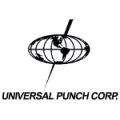Piercing and hole punches

Universal Punch Corporation's piercing punches are used for punching and cutting holes in sheet made from metal and other materials. Piercing punches are precision component press tools which are subjected to the highest stress. Their advantages and full capacity can only be fully demonstrated if all other components in the press tool are also precision made.
Universal piercing punches are known for their quality and great life expectancy in all appropriate industri. They are produced according to various standards and customers’ drawings: Piercing punches according to DIN 9861, part 1 and 2 are manufactured with 60° countersunk head: Type DA (parallel) and CA (with stepped shaft) are standard designs, in which the 60° countersunk head is precison ground. As the flowlines of the material are continuous, these parts can withstand great stress on the return stroke. These standard parts will permit swelling immediately under the head of max. 0.02 - 0.04 mm. Types D and C are plunge cut ground in one piece, whereby the tolerance h6 is maintained over the whole length of the shaft and the head. A perfect fit of the punch head in the tool fixture is only guaranteed if these precision parts are positioned in precise mounting boreholes. To facilitate higher cutting and withdrawal force, we recommend punches of type CA or C, as these have larger punch profiles for the resulting forces. For piercing printed circuit boards, piercing punches are manufactured in accordance with DIN 9861 with highly precision ground surface (Rz 0.4 - 0.6 μ).
Universal Punch Corporation has been offering piercing punches with bottle neck and trombone neck heads over many years. The largely expanded radius will reduce the danger of breakdown under the head even further. Piercing punches according to ISO 8020 are produced with cylindrical head in types A / B / E and F. They are basically plunge cut ground. Piercing punches type A and B with cylindrical head (according to DIN 9844) are also plunge cut ground. In contrast to ISO 8020, a wider diameter range is available. Piercing punches DIN 9840, Part 1 and 2 are specially made for cutting sheet metal perforations. The 40° countersunk head, used for this purpose, facilitates close positioning of the punches due to less space requirement in the tool fixture providing less danger of fracture under the head. Square/rectangular and profile punches in accordance with DIN 9846 are available with or without head, with transverse hole or tapped blind hole. Over and above they can be produced according to customers’ drawings. For the different applications we use the following materials: WS with average wear resistance x HWS with high wear resistance x HSS with extremely high wear resistance or for difficult to work materials x ASP 30 with excellent wear resistance.
For tools subjected to very high demands in the electrotechnical and electronics industry, especially powder metallurgy manufactured steel, HSS steel ASP 30 & 60 /ASP 2060/CPM 1OV/CPMREX M4 has gained acceptance.
By using a surface coating, the life expectancy can be greatly extended. UNIVERSAL recommends the use of TIN coatings, which can save the tool maker a great deal of money by extending the life expectancy of the piercing punches considerably. Today, we mainly offer the following coatings: TIN (PVD) colour: gold-yellow (2200 - 2400 HV 0.05) TICN (PVD) Colour: blue-grey (approx. 3000 HV 0.05) Tenifer-bath nitrated, colour: grey-black (approx. 1000 HV 0.3 = 70 HRC).
- Round piercing punches DIN 9861 part 1 type D #570
- Round piercing punches DIN 9861 part 2 type C #571
- Round piercing punches ISO 8020 type A #572
- Round piercing punches ISO 8020 type B #573
- Round piercing punches ISO 8020 type E #574
- Round piercing punches ISO 8020 type F #575
- Round piercing punches DIN 9844 type A #576
- Round piercing punches DIN 9844 type B #577
Technical data available here >

